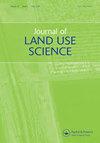基于服务设施容量的神经网络城市居住用地利用效率评价
IF 3.3
4区 环境科学与生态学
Q1 AGRICULTURE, MULTIDISCIPLINARY
引用次数: 1
摘要
本文提出了一种基于服务设施容量的城市居住用地利用效率评价方法。利用可公开获得的数据获取物理和社会经济信息。结合由居住人口计算的实际承载力和由服务设施密度计算的理论承载力,训练了一个反向传播神经网络来评估居住用地的利用效率。结果表明,住宅用地利用程度可以通过服务设施承载能力来反映。北京住宅用地效率呈现出由中心向边缘递减的空间分布形式。我们还发现了行政区域交界处居住用地效率相对较低的现象。我们的研究展示了如何应用多源公开可用数据和神经网络算法来解决复杂的社会问题。本文章由计算机程序翻译,如有差异,请以英文原文为准。
Evaluation of urban residential land use efficiency with a neural network from the perspective of service facility capacity
ABSTRACT We demonstrate a method to evaluate the urban residential land use efficiency from the perspective of service facility capacity by using a neural network. Publicly available data were used to obtain the physical and socioeconomic information. Combining the actual carrying capacity calculated from the residential population and the theoretical carrying capacity calculated from the service facility density, we trained a back-propagation neural network to evaluate the efficiency of residential land use. The results show that the degree of residential land use can be reflected through the carrying capability of service facilities. Beijing’s residential land efficiency presents a spatial distribution form that declines from the centre to the edge. We also found a phenomenon that the efficiency of the residential land at the junction of administrative districts is relatively low. Our research demonstrates how multi-source publicly available data and neural network algorithms can be applied to solve complicated social issues.
求助全文
通过发布文献求助,成功后即可免费获取论文全文。
去求助
来源期刊

Journal of Land Use Science
Environmental Science-Management, Monitoring, Policy and Law
CiteScore
5.40
自引率
6.20%
发文量
26
期刊介绍:
The Journal of Land Use Science provides a central outlet for high-quality articles on theoretical and empirical aspects of land-use science at the interface of social and environmental systems. The Journal brings together an array of research perspectives at multiple temporal, spatial and social scales that contribute a better understanding of land-system dynamics and communicate scientific advances towards attaining land-system sustainability.
 求助内容:
求助内容: 应助结果提醒方式:
应助结果提醒方式:


